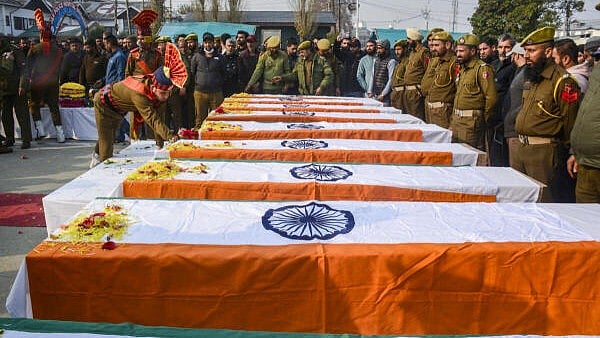
Police and security personnel pay tribute to the nine persons killed in the accidental blast at Nowgam police station.
Credit: PTI Photo
Srinagar: What began as a routine probe after Jaish-e-Mohammad terror outfit threat posters surfaced in Srinagar’s Nowgam area in mid-October has now spiralled into one of Kashmir’s most complex investigations — drawing in doctors, traders, and links to an interstate academic network stretching all the way to Al-Falah University in Haryana.
As investigating agencies widen the net, the focus has shifted from the posters themselves to the people quietly operating behind seemingly ordinary lives.
Over the past week, the investigating agencies have carried out a series of coordinated raids across Srinagar and south Kashmir districts of Anantnag, Kulgam, Shopian and Pulwama.
What they have recovered — from phones and laptops to travel documents — suggests a pattern of movement and communication that overlaps suspiciously with the timeline of the Faridabad explosives haul, the Red Fort car blast, and the Nowgam police station tragedy in which seized explosives detonated during examination.
A key operation took place late Saturday in Anantnag’s Malaknag locality, where sleuths searched the house of a local doctor. Inside, they found a female doctor from Haryana residing as a tenant, prompting new scrutiny of her movements and contacts.
Her mobile phone was seized and sent for forensic examination as investigators work to determine whether her presence in the house was coincidental or part of a deeper operational pattern.
In the Qazigund area of Kulgam, the investigation took an alarming turn when Bilal Ahmad Wani, a dry-fruit seller questioned in the case, reportedly attempted to set himself on fire. Wani — a neighbour of key accused Dr Adeel Rather and Dr Muzaffar Rather— had been detained with his son Jasir last week. While Jasir remains in custody, Bilal is under treatment at GMC Anantnag for burn injuries and is stated to be stable.
The Rather brothers remain central to the investigation. Dr Muzaffar, believed to be the primary handler, is suspected to have fled to Afghanistan. His younger brother, Dr Adeel, was arrested in Saharanpur on November 6 and continues to face sustained interrogation. Investigators suspect the two leveraged their professional status and interstate mobility to mask movements of material, money or operatives connected to the explosives recovered in Haryana.
Raids over the last week have produced notebooks, external drives and travel itineraries showing repeated Delhi-Haryana-Kashmir movement — some coinciding directly with periods when explosives are suspected to have been sourced or moved. Those detained so far are being questioned to map the social and operational chain rather than being treated as accused.
As agencies connect the dots between the Nowgam posters, the Faridabad explosives, the Red Fort attack and the Nowgam police station tragedy, the probe is increasingly centred on individuals whose unobtrusive daily lives may have concealed the architecture of the entire operation.